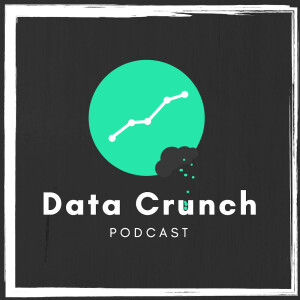
Digital Twins, the Internet of Things, and Machine Learning
 2018-07-31
2018-07-31
Download
Right click and do "save link as"
Bruce: Where AI, and in particular machine learning, and then in particular neural networks, and then in particular deep learning neural networks, where they apply is mostly in this model making, so with IoT, there are two types of models for the digital twin: we have the analytical model that's created through more analytical techniques, and then we have the cognitive models that are being created through a machine learning and artificial intelligence techniques. I kind of like to separate the two, but the the impact in both cases are profound.
Ginette: I’m Ginette.
Curtis: And I’m Curtis.
Ginette: And you are listening to Data Crunch.
Curtis: A podcast about how data and prediction shape our world.
Ginette: A Vault Analytics production.
Today, if you haven’t guessed already, we’re talking about the intersection of data, artificial intelligence, and the internet of things, or IoT. So we’re talking to an expert well versed in this topic. A little bit about his background: Among many other things he’s done, like found and head companies, he’s authored a book on the Internet of Things, created a certification program for people who want to become certified IoT professionals, and he explains all things IoT on his podcast called “The Internet of Things Business Show.” Today, we’ll learn about AI in the IoT world and more specifically digital twins—a concept named by Gartner two years in a row now as one of the top ten strategic technology trends for both 2017 and 2018. Let’s dive into this topic with our guest.
Bruce Sinclair: My name is Bruce Sinclair. I am the president of IoT Inc. We consult for brands, manufacturers, and vendors and help them with their IoT strategies, both on the business side and on the product side, and we produce content, so part of the content is the podcast, and we do trainings, so we're training executives on how to introduce IoT within their business, and how to—most importantly—be profitable with IoT, and the reason I started IoT Inc. was that I saw pretty quickly that there was a lot of hype around the Internet of Things, and this hype was all around the shiny new things, in particular the technology, but as most technologies, they run out of steam if they can't make any money. And so I was very deliberate in focusing on the business aspect of IoT to try to help executives and managers to understand how to apply this technology.
Curtis: One of the most important concepts in IoT is the digital twin, which is a virtual reflection of a physical object. One major use of the digital twin is taking the virtual reflection of an object and virtually change it before actually changing things in the physical object in the real world. Today a digital twin is generated from data coming from sensors embedded in a physical object.
Bruce: So the Internet of Things, for everyone that’s listening, is really just the Internet being put into physical objects. The Internet being networking, things being the device. That's really, at least when you look at it from a business perspective, that’s not where the action’s at, and not coincidentally, where the action’s at is in data analytics, data science, and a subset of that being AI, and the purpose of putting the Internet in the physical objects at the highest level is to capture data. So we capture data in our sensors, which is more of our internal data sources, and we capture data on the Internet, and that is using business systems, that is using microservices, and coincidentally or interestingly, it's also other products, and this leads us to the most important technology for the Internet of things and this is the digital twin, and the digital twin is the virtualization of the physical into the digital, so this is where it kind of allows us to take the physical world and start applying analytical techniques to the data that we gather from it so that we can create value.
Ginette: While the concept of a digital twin is a hot topic right ...
view more
More Episodes
Creating a Database for AI with Activeloop
 2022-03-24
2022-03-24
 2022-03-24
2022-03-24
Streamlining Construction with AI
 2021-12-17
2021-12-17
 2021-12-17
2021-12-17
The Future of Unstructured Data with Graviti
 2021-10-29
2021-10-29
 2021-10-29
2021-10-29
Data Strategy in the Education Sector
 2021-10-01
2021-10-01
 2021-10-01
2021-10-01
Cyber Security in Higher Ed
 2021-07-31
2021-07-31
 2021-07-31
2021-07-31
Telmo Silva Talks ClicData
 2021-05-04
2021-05-04
 2021-05-04
2021-05-04
Pricing with Cactus Raazi
 2021-04-16
2021-04-16
 2021-04-16
2021-04-16
AI Making Developers more Effective
 2021-03-25
2021-03-25
 2021-03-25
2021-03-25
Overcoming Cultural Hurdles in Tech
 2021-02-27
2021-02-27
 2021-02-27
2021-02-27
Traffic Equilibrium and a PhD
 2021-01-30
2021-01-30
 2021-01-30
2021-01-30
Machine Learning and Flight with Ian Cassidy
 2020-12-31
2020-12-31
 2020-12-31
2020-12-31
Implementing ML Algorithms with Ylan Kazi
 2020-12-01
2020-12-01
 2020-12-01
2020-12-01
Hiring Top Tech Talent
 2020-10-31
2020-10-31
 2020-10-31
2020-10-31
Making Data Assets Profitable with VDC
 2020-09-30
2020-09-30
 2020-09-30
2020-09-30
Machine Learning with Max Sklar
 2020-08-28
2020-08-28
 2020-08-28
2020-08-28
Think Differently with Graph Databases
 2020-07-31
2020-07-31
 2020-07-31
2020-07-31
Data, Epidemiology, and Public Health
 2020-07-17
2020-07-17
 2020-07-17
2020-07-17
012345678910111213141516171819
Create your
podcast in
minutes
- Full-featured podcast site
- Unlimited storage and bandwidth
- Comprehensive podcast stats
- Distribute to Apple Podcasts, Spotify, and more
- Make money with your podcast
It is Free
- Privacy Policy
- Cookie Policy
- Terms of Use
- Consent Preferences
- Copyright © 2015-2024 Podbean.com




